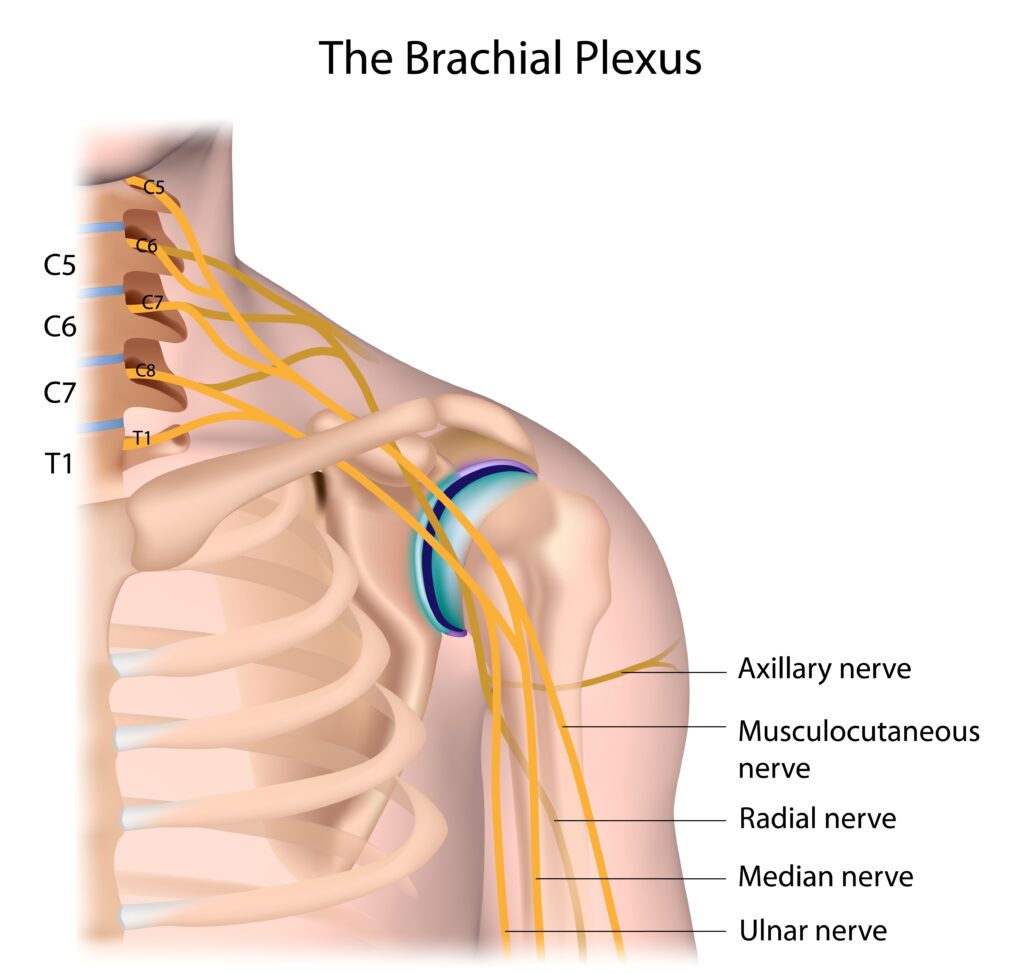Parsonage-turner syndrome, also called brachial neuritis or neuralgia, is a neurological disorder causing severe pain followed by lasting damage to the nerves and muscles. Generally, this condition affects the nerves that make up the brachial plexus in the shoulder. However, any nerve in the body is at risk. We think the immune system triggers this condition after a common viral infection such as a cold. So what is parsonage-turner syndrome or brachial neuralgia, and what does it mean for someone affected?

Symptoms of brachial neuralgia
Generally, this neurological disorder starts with severe pain in the shoulder or upper arm. Then, pain is usually followed by wasting and weakening of muscles affected over days to weeks.
Usually, the symptoms occur in two phases: the acute phase and the chronic phase.
In the acute phase, the pain usually occurs on one side, only affecting the shoulder, arm, and neck. Pain is variable such as sharp, burning, or throbbing, although almost always severe. Sometimes, the pain may be accompanied by pins and needles or numbness in the shoulder or arm. This phase can last anywhere from hours to weeks.
In the chronic phase, there is lasting damage to the muscles and nerves. Once the acute pain settles, people notice a gradual loss of strength and muscle wasting related to the damage to the muscles and nerves. This damage can range from a barely noticeable loss of power in the arm to gross weakening of the shoulder muscles and severe weakness.
Sometimes, muscle damage and wasting near the shoulder can lead to a frozen shoulder. In more severe cases, the circulation can be affected, leading to swelling and discoloration of the skin, excessive sweating, and coldness of the hands and fingers.
Causes of parsonage-turner syndrome
We still don’t know why this condition occurs. However, we think that various environmental factors trigger the immune response leading to nerve inflammation. Examples include childbirth, immunisations, infections, and surgery.
How do we diagnose brachial neuralgia?
Generally, we diagnose this condition by using the presenting clinical features with testing such as MRI and nerve conduction studies. Often, tests are normal in the acute phase before muscle weakness and wasting begins.
It is essential to rule out other causes of nerve pain and muscle wasting, such as a bulging disc in the neck, peripheral neuropathy, or other causes of nerve inflammation.
Parsonage-turner syndrome MRI

MRI of the arm and brachial plexus is useful for finding the damage to nerves, identifying the muscles affected, and ruling out other causes of shoulder and arm pain. Sometimes, pain and muscle wasting can be due to the growth or tumour of the nerves and should be ruled out.
Other tests include nerve studies or EMG to identify the extent and site of damage to the nerves and muscles.
Sometimes, we perform other investigations such as X-rays or blood tests to ensure you don’t have another problem.
Brachial neuritis vs. radiculitis: how do you tell the difference?
A disc bulge often triggers radiculitis or inflammation of the nerves in the neck. Generally, radiculitis presents differently from brachial neuritis. Usually, people with radiculitis suffer from neck pain shooting down the arm and into the hand. Often, there is weakness of the arm or hand but no significant wasting. In general, movement of the neck brings on the symptoms.
Parsonage-Turner syndrome treatment
Treatment aims to relieve acute symptoms and improve the function of muscles and tendons.
Treatment of acute pain may need pain killers such as ibuprofen or codeine. Often, physical therapy can relieve pain in muscles and joints. Hot and cold compresses, and a machine called TENS, which sends electrical impulses to the muscle, can help. For longer-lasting pain, medications for neuropathic pain such as amitriptyline may help.
Physical therapy exercises for Parsonage-Turner syndrome
Generally, we recommend intensive exercise therapy to stimulate nerve function and restore muscle activity. Usually, people do exercises to regain movement of the shoulder and arm. Then, strengthening exercises help to restore muscle bulk.
Commonly asked questions about brachial neuritis.
Is there a cure for parsonage-turner syndrome?
No, but in most cases (85-90%), people regain strength and function over many months. However, that leaves about 10-15% with ongoing pain problems and loss of shoulder function. Sometimes, we recommend surgery to repair tendons or nerves affected, such as a nerve transplant.
Can Parsonage-tuner syndrome recur?
Yes. We think the recurrence rate is about 25% and often occurs on the other side or another limb.
Can the COVID or flu vaccine cause Parsonage turner syndrome?
Yes. We suspect that immunizations can trigger this condition as well as viral infections.
Are there treatments to speed up the healing of the tendons?
There are no recognised active treatments for brachial neuritis. However, some doctors are using immune globulin with mixed results.
Final word from Sportdoctorlondon about brachial neuritis
Parsonage-turner syndrome is a common cause of severe pain in the shoulder followed by weakness and wasting of the muscles. It is essential to see a doctor specialising in diagnosing this condition and excluding other conditions.








Thank you have learnt the condition that my son has,,, looking forward to know more
I have been living with this for almost two years now.
I awoke abruptly in the early hours with the most intense pain I have ever experienced. I had really never felt anything like it. This went on for four days. I couldn’t get to see my GP due to COVID and so took myself to A&E…to be told by the Dr that I was wasting time. Fast forward a couple of months I finally managed to get in to see my GP (practice nurse in the end) and was referred to the Musculoskeletal dept at our local hospital. Following on from that it took 6 months to get a diagnosis and with that I was told ‘it will get better’ and sent home.
Well, my arm is still numb. The strength has not returned, I guess it’s running at 65%. Movement is still limited and slightly more concerning is the constant pain running from the troubled area, across the shoulders and up my neck to the base of the skull.
Not a pleasant experience. I am looking into private advice and tests here in the UK to see if there are other issues at play.
I suppose it depends on the diagnosis and what tests were done/advised. If you email my practice directly, i can advise.
Regards
Lorenzo
Good afternoon, just read an article about brachial neuritis and your message. How’s it going now? I was diagnosed with it and having physio and take medication.
that’s fantastic – all the best
LM
There are several reports of Covid-related Parsonage Turner (Zazzara et al. BMC Neurology (2022) 22:96 https://doi.org/10.1186/s12883-022-02622-4). My husband has had 4 distinct episodes of Parsonnage Turner: medial head of the triceps (1984), serratus anterior (1993) and most recently, the left brachial plexus (2017, 2021). Each episode recovered after 1-2 years, leaving him with a mild, residual deficit.
Symptoms in the left brachial plexus restarted last week to the extent he was no longer able to use the arm. Coincidentally, he was diagnosed with mildly symptomatic covid, and was treated with bebtelovimab (monoclonal antibody infusion). Within 24 hours of the drug infusion, strength in the left arm returned and is almost back to baseline.
As there is no effective treatment for Parsonnage Turner, and this rapid improvement could not be just a simple coincidence. Perhaps there should be further investigation into the use of monoclonal antibodies, at least as it related to covid-induced Parsonnage Turner.
I was diagnosed with Brachial Neuritis 10 years ago. It started with me waking in the early hours of the morning with severe and intense pain in my left arm. This spread over to my right arm as well. I later had winging of the scapular with a large amount of muscle loss in the area and in my arms. I carried out physio for several years and the muscle loss returned. However, 10 years on I am still getting pain in the arms (particularly my right arm now) which keeps me up at nights (it is 2am as I write this as the pain in my arm is preventing me from sleeping). Is there anything that can be done? I have private health insurance and am covered for this so I don’t have to fully rely upon the NHS.
Hi Robin,
You need further assessment to find the causes of your pain. I’d recommend nerve studies combined with other imaging, such as MRI (if clinically indicated). Treatment options include medication for nerve pain https://sportdoctorlondon.com/amitriptyline-for-pain-side-effects/
LM